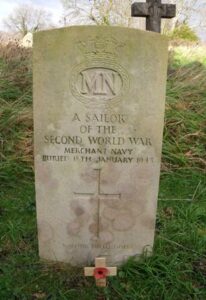Tenby is one of the most attractive towns in West Wales, which can be seen by the number of visitors each summer. The town has a long history, with its castle being in a prominent position overlooking the sea, and the ancient town walls still standing. As a popular beauty spot in Victorian times, Tenby played host to a number of important families, and this can be seen in the large proportion of Officers on the War Memorial, which is sited at Trafalgar Gardens. Many Thanks to Les Nixon for his much appreciated photos of the War Memorial panels from which the names of the fallen were taken. This page commemorates the fallen of the town during World War Two.
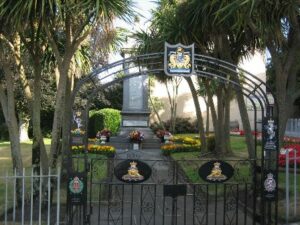
World War Two, 1939-1945
William Donald Allies, Flight Lieutenant, 41978, Royal Air Force. William was the son of William Kenneth and Marguerite Allies. He married Kathleen Marjorie Harman, of Tenby, in 1939. William served with 214 Squadron, Royal Air Force, which was equipped with the Boeing Flying Fortress, and flew on radio counter-measure missions, detecting and jamming enemy radio and radar equipment. William was killed when his aircraft was lost over the sea on 22 March 1945. He was 30 years old, and is commemorated on the Runnymede Memorial, Surrey. William is not commemorated at Tenby.
Bernard Ollin Badham, Stoker 2nd Class, D/KX. 164530, Royal Navy. Bernard was born on 13 March 1923, the son of William Ollin Badham and Doris Mary Badham, of Saundersfoot, and served with the Royal Navy aboard H.M.L.C.S. (L) 255. This was a Landing Craft, which was designated His Majesty’s Landing Craft Support (Small), No. 255. Bernard sadly died as the result of an accidental explosion on 17 October 1943, aged just 20. He is buried at Saundersfoot (Bethesda) Presbyterian Church of Wales Chapelyard. His brother Geoffrey also fell.
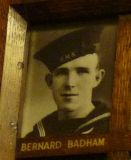
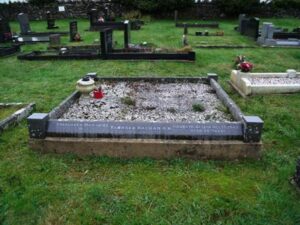
Geoffrey David Badham, Boy 1st Class, D/JX.171749, Royal Navy. Geoff was born on 6 April 1924, the son of William Ollin Badham and Doris Mary Badham, of Saundersfoot, and served in the Royal Navy, aboard HMS Maori. Maori was a Tribal Class destroyer that had been launched on 2 September 1937. She was involved in the pursuit of the Bismarck, and served with the 4th Cruiser Squadron, which was part of the Mediterranean Fleet, at the Battle of Cape Bon, off the coast of Tunisia during December, 1941. Geoffrey may have been injured during the Battle, as he died just days later at Alexandria, on 30 December 1941, aged just 17, and is buried at Alexandria (Hadra) War Memorial Cemetery. The Maori was finally sunk while anchored at Malta on 12 February 1942, when she went down with the loss of one crew member. His brother Bernard also fell.
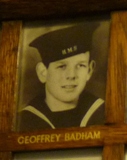
Kenneth Humphrey Bancroft, Captain, Malay States Defence Force. Kenneth was the son of John and Charlotte Bancroft, of 3, Esplanade, Tenby. He served with the Malay States Defence Force (Kedah Volunteer Force), and was taken prisoner by the Japanese during their invasion of Thailand and Burma. He was sent to work on the infamous Thailand to Burma Railway, made famous by the Bridge on the River Kwai, and died in captivity on 22 December 1942. He was 37 years old, and is buried at Kanchanaburi War Cemetery, Thailand.
Raymond Bloch, Sergeant Major, Belgian Forces. Raymond was born in Belgium in 1904, and had been among the Belgian soldiers who had escaped from Dunkirk in May 1940. He was based at Penally when he met and married Kathleen James, of Upper Frog Street, Tenby in 1941. Raymond was then posted to London, and was on duty there when he was killed in an air raid in 1944. Kathleen died in 2002, having never remarried. Raymond is not commemorated at Tenby.
David Robert Booker, Sergeant (Air Bomber), 1413457, Royal Air Force Volunteer Reserve. David was born in India on 28 February 1923, the son of Arthur Booker, an engineer, and Mary Booker. In May 1926 the family returned home from India and settled back at Osborne House, Harris Street, Tenby. David was educated at Greenhill Grammar School and at Christ College. He enlisted into the Royal Air Force Volunteer reserve soon after the outbreak of war and after training as an Air Bomber was posted to 156 Squadron, Royal Air Force, which was part of the elite Pathfinder Force, armed with the Avro Lancaster heavy bomber. David was taking part in his third mission when his Lancaster, serial EE118, took off from RAF Warboys on 29 September 1943, bound for Bochum. The crew found their target and returned home, but sadly crashed near Downham Market, Norfolk on the return leg, killing most of the crew, including David. His body was taken back to Tenby, where he was laid to rest at St. Mary’s Church Cemetery.
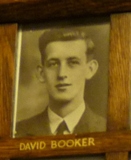
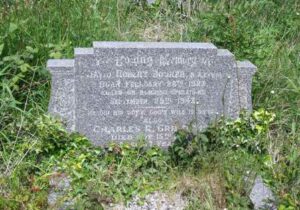
Ivor Henton Brace, Civilian Air Raid Victim, Auxiliary Fire Service. Ivor was the son of John and Mary Brace, of Knightson Lake, New Hedges, Tenby. He lived at 6 Cornwall Mews, London, where he served with the Auxiliary Fire Service. Ivor was killed at Elvaston Place, London, during an air raid on 11 May 1941. He was 27 years old.
William Francis Collister Clague, Sergeant (Air Gunner), 1070408, Royal Air Force Volunteer Reserve. William was the son of William and Helena Clague, of Douglas, Isle of Man. He married Constance Gertrude King, of Tenby, in 1933. He served with 460 (Royal Australian Air Force) Squadron, RAF, based at RAF Binbrook, and equipped with the Lancaster heavy bomber. William’s last flight was as a Flight Engineer on 29 May 1943, when his Lancaster III, Serial W4985, took off from RAF Binbrook, bound for Wuppertal. His Lancaster was shot down over Germany by anti-aircraft fire the following morning of 30 May 1943, killing William, the Pilot T P Russell, Bomb Aimer T Taylor, W/OP P W Findlay, and Gunner D B Gordon. William was 33 years old, and is buried at Rheinberg War Cemetery, Kamp Lintfort, Nordrhein-Westfalen, Germany.
Eric Henry Clark, Cabin Boy, Merchant Navy. Eric was born at Narberth in 1922, the son of Robert Charles Clark and Clara Elizabeth Elderton Clark. Robert had moved the family to Tenby during the Great War, where he was an instructor with the local Royal Garrison Artillery. Eric was educated at Greenhill School, before joining the Merchant Navy, and served aboard S.S. Mill Hill, a Newcastle-on-Tyne registered cargo vessel. On 16 August 1940 Mill Hill left Halifax, Nova Scotia as a member of convoy HX-66A laden with pig iron and scrap steel, bound for Middlesbrough. Early in the morning of 30 August 1940, she was 58 miles off Cape Wrath in the north of Scotland, when she was torpedoed by the German Submarine U-32, sinking within a few minutes with the loss of all hands. Eric was just 18 years old when he died that day, and is commemorated alongside his fellow crew-members on the Tower Hill Memorial, London. His brother Lionel also fell.
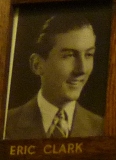
Lionel Elderton Clark, Assistant Cook, 118385, Naval Auxiliary Personnel (Merchant Navy). Lionel was born in Sussex in 1916, the son of Robert Charles Clark and Clara Elizabeth Elderton Clark. Robert had moved the family to Tenby during the Great War, where he was an instructor with the local Royal Garrison Artillery. Lionel was educated at Tenby Council School and Greenhill School, before joining the Merchant Navy, and served aboard HMS Jervis Bay as an Assistant Cook. Jervis Bay was a liner which had been converted into an Armed Merchant Cruiser in August 1939. On 5 November 1940, she was the sole escort for the 37 ship Convoy HX-84 from Halifax, Nova Scotia to Britain, when the convoy encountered the Pocket Battleship Admiral Scheer. The convoy scattered, and Jervis Bay set a course straight towards the German warship to draw its fire. Jervis Bay was hopelessly outmatched, and was sunk in the engagement. Lionel was killed in the sinking that day. He was 23 years old, and is commemorated on the Liverpool Naval Memorial. His brother, Eric Henry Clark also fell.
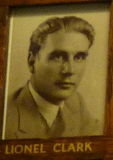
Hugh Anthony Stapledon Cotterill, Captain, IA/1141, 13th Frontier Force Rifles. Hugh was the son of Major Hugh Stapledon Cotterill, MC, and Florence Marjorie Cotterill, of Tenby. He was commissioned into the Indian Army on 13 January 1940, and served with the 13th Frontier Force Rifles. Hugh fought with his battalion in the Burmese campaign. He was killed on 7 March 1942, aged 22, and is commemorated on the Rangoon Memorial, Myanmar. Hugh is not commemorated at Tenby.
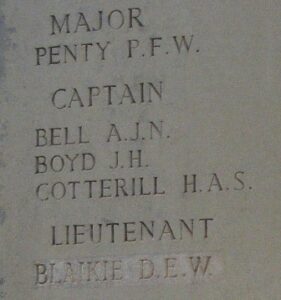
William Robert Frederick Creese, Lance Bombardier, 858954, Royal Artillery. William was the son of Stephen and Florence Creese, of 8, Jones Terrace, Tenby. He married Elisabeth Ann Pullin, of Tenby in 1934. He served with 17 Medium Regiment, Royal Artillery, which fought in North Africa, before taking part in the invasion of Italy. William was killed in Italy on 3 May 1945. He was 31 years old, and is buried at Bologna War Cemetery, Italy.
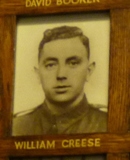
Thomas Edmund Cremer, Lieutenant, Royal Marines. Thomas was born on 8 January 1912, the son of Francis Woodrow Cremer and Fanny Georgina Cremer, of Swannington, Norfolk. He married Nancy Veronica Fulton at Paddington in 1937. Thomas was commissioned as Second Lieutenant with the Royal Marines on 11 August 1941, and served with the Royal Marine Signal Division, being promoted to Lieutenant within months. He was killed during an accident on 10 July 1942, aged 30. He is buried at Tenby (St. Mary) Church Cemetery. His widow Nancy had married Edward Hartley within five months. Thomas is not commemorated at Tenby.
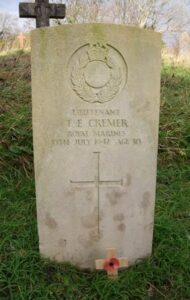
Richard Charles Luke Cummins, 1652396, Sergeant (Air Gunner), Royal Air Force. Richard was born in Tenby in 1923, the son of Richard Cornelius Cummins and Mary Margaret Cummins (nee McHardy). His parents later resided at Nailsea, Somerset. Richard served with 90 Squadron, Royal Air Force. The Squadron flew the Short Stirling III heavy bomber, based at RAF Wratting Common. Richard was killed during a raid over Germany on 23 September 1943. He was 19 years old, and is buried at Hanover War Cemetery, Germany.
William Karl Davies, DSM, Lieutenant, Royal Naval Volunteer Reserve. William was the son of William and Caroline Davies, of Tenby, and the Husband of Emma Davies, of Brixton Hill. He had served in the Royal Navy for over 40 years by the outbreak of WW2, and had been awarded the Distinguished Service Medal during the Great War. William was a Freeman of Tenby. He was based in Cornwall when he died on 17 July 1943, aged 61. William is buried at Lambeth (Tooting) Cemetery, London. William is not commemorated at Tenby.
Kenneth Arthur Diment, Craftsman, 7588455, Royal Electrical and Mechanical Engineers. Kenneth was the son of Captain John Bennett Diment and Winnifred Mabel Diment (nee Pitkin) of Tenby. He served during the war with the Royal Electrical and Mechanical Engineers, but sadly little else is known of him. Kenneth died on 30 September 1945, aged 24, and is buried at Tenby (St. Mary) Church Cemetery.
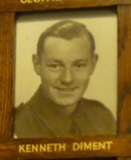
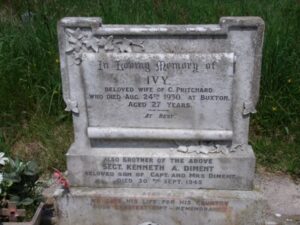
Patrick Lewis Dunne, Petty Officer, P/J 108617, Royal Navy. Patrick was the son of Patrick and Mary Ann Dunne, of 2, Hamilton Terrace, Upper Park Road, Tenby. He married Doris Myrtle Thompson, of St. Dominic’s Cottage, Carisbrook, Isle of Wright, prior to the war. Patrick served in the Royal Navy aboard the battlecruiser HMS Hood. When war was declared, Hood was operating in the North Atlantic. On 24 May 1941 she intercepted the German pocket battleship Bismarck. The mighty ships began to rain shells down at each other, but a salvo from Bismarck struck Hood in the aft magazines, and the ship exploded and sunk, with the loss of all bar three of her crew of 1,418. Patrick was 33 years old when he died that day, and is commemorated on the Portsmouth Naval Memorial, Hampshire. Patrick is not commemorated at Tenby.
James M Edwards, Lieutenant, 137146, Royal Horse Artillery. James was the son of William Stanley Edwards and Elsie Margaret Edwards, and was commissioned into the Royal Artillery. He served with their 4th Regiment, and took part in the Normandy landings, in the subsequent break-out from Normandy, and the drive north into Belgium and Holland. James was killed in Holland on 18 November 1944. He was 24 years old, and is buried at Swartbroek Churchyard, Netherlands.
John Theodore Eshelby, Pilot Officer (Flt Engr.), 185304, Royal Air Force Volunteer Reserve. John was the son of Edgar Boulton Eshelby and Alma Eshelby. He married Yvonne Therry at Tenby in 1940. John served with 460 Squadron, Royal Air Force, which was an Australian Squadron, which flew the Short Sunderland ‘flying boat’. John was killed on 3 January 1945 when his Sunderland, ML738, crashed during take-off at Alness, Scotland, killing five of her crew. John was 36 years old when he died, and was brought back to Tenby for burial at Tenby (St. Mary) Church Cemetery. Yvonne later resided at Maida Vale, London. John is not commemorated at Tenby.
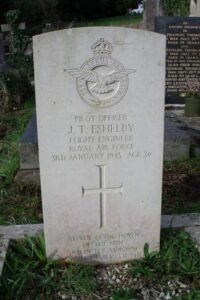
David Gwynne Evans, Flying Officer (Pilot), 132703, Royal Air Force Volunteer Reserve. David was the son of Sydney Charles and Evelyn Caroline Evans, of Hillside, Greenhill Avenue, Tenby. He was educated at Greenhill School before enlisting into the Royal Navy, training as an Engine Room Artificer at Portsmouth. David then became interested in flying, and left the Royal Navy to train as a Pilot with the Royal Air Force Volunteer Reserve. David then learnt to fly in Canada, with the Empire Air Training School, alongside David Booker from Tenby. Upon his return, he served as a Pilot with 86 Squadron, RAF, which was an anti shipping squadron, equipped with the Consolidated Liberator V. On 23 October 1943, David was co-pilot aboard Liberator FL954, which was detailed for convoy escort duty in the Atlantic. The aircraft took off but soon developed technical problems, and crashed at Lough Foyle, County Derry, Ireland, killing all eight of the crew. David was 22 years old, and was brought home to be buried at Tenby (St. Mary) Church Cemetery.
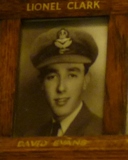
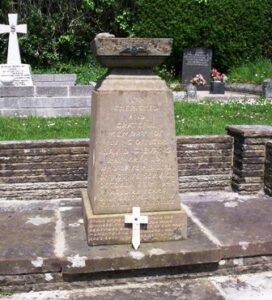
Norman John Evans, Captain, 193795, the Welch Regiment. Norman was born on 15 August 1916, the son of John Henry Tennent Evans and Elizabeth Evans (nee Badham), of 33, Brewery Street, Pembroke Dock. The family then moved to 19, Trafalgar Road, Tenby. Norman was originally commissioned from the Welsh Guards into the Welch Regiment on 11 July 1941, probably after serving with the Welsh Guards during the fall of France in 1940. He was attached to the 9th Battalion, Cameronians for the invasion of Normandy. The battalion was attached to 46 Brigade, 15th (Scottish) Division, and landed on 17 June 1944 onto the Normandy beaches. In the coming weeks, the Division took part in the break out from the beaches, and took part in heavy fighting. Norman was killed on 11 July 1944, aged 27. He is buried at Beny-Sur-Mer Canadian War Cemetery, Reviers, France. His brother Richard Charles Evans also fell.
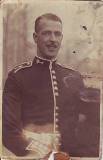
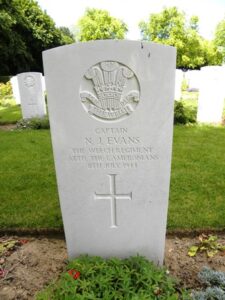
Richard Charles Evans, Private, 14206505, the Somerset Light Infantry (Prince Albert’s). Richard was born on 16 June 1923, the son of John Henry Tennent Evans and Elizabeth Evans (nee Badham), of 19, Trafalgar Road, Tenby. He served with the 4th Battalion, Somerset Light Infantry, which was attached to 129 Brigade, 43rd (Wessex) Division. The brigade landed on the Normandy beaches on 23 June 1944, and took part in the break out from the beach-head. Richard was killed just days after landing, on 29 June 1944, aged 21. He is buried at St. Manvieu War Cemetery, Cheux, France. His brother Norman John Evans also fell. Richard is to the left in the photograph. His brother Norman is alongside him.
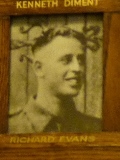
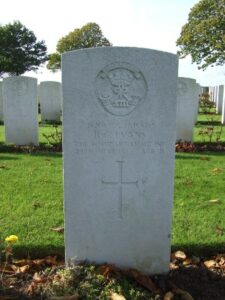
The Reverend Edward Thomas George, Chaplain 4th Class, 178165, Royal Army Chaplains’ Department. Edward was born at Treorchy in 1895, the son of John and Hannah George. He was educated at University College, Cardiff and Memorial College, Brecon, before serving during the Great War with the Royal Air Force. Edward was serving as the Chaplain to the United Boards Troop at Pembroke Dock from 1925. He married Helen Mary Sandercock of Tenby in 1927, and the couple resided at 135, Station Road, Tunstall, Stoke-on-Trent after 1929. Upon the outbreak of WW2, Edward became Chaplain to the 22nd Battalion, Royal Fusiliers (City of London Regiment). He died at Colchester on 21 June 1941, aged 46, and is buried at Tenby (St. Mary) Church Cemetery. Edward is not commemorated at Tenby.
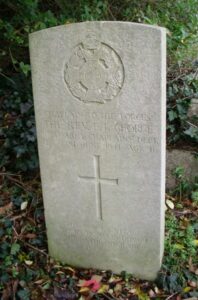
Arthur Richard John Glass, Corporal, 5569252, Royal Army Ordnance Corps. Arthur was born in Swindon on 2 May 1913, the son of Arthur Glass and Margaret Ann Glass (nee Brooking), of 99, Roseberry Street. His father, a soldier, was killed in Flanders in October 1914, so his mother moved back to her native Tenby, setting up home at 12, The Flats, Bridge Street. Arthur was educated at Tenby Council School. Following the outbreak of war he enlisted into the army and joined the Royal Army Ordnance Corps, attached to the 53rd (Welsh) Division. Arthur served throughout the entire duration of the war, and was still serving after the surrender of Germany and Japan. Unfortunately his wartime service appears to have taken its toll on his health, and Arthur died at Sealyham Hospital, St. Dogwells on 9 October 1946. The 33-year-old was buried in St. Mary’s Church Cemetery, Tenby five days later. Arthur is not commemorated as a casualty of war by the CWGC.
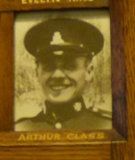
Richard Henry Glue, Major (Quartermaster), 39029, Royal Engineers. Richard was the son of Richard and Frances Glue, of Dover, Kent. Richard had followed his father into the army as a career soldier, and had married Evelyn Daisy John on 26 April 1907. He served during the Great War with the Royal Engineers. Richard had been posted to Pembroke Dock at the outbreak of WW2, moving his family there before settling at Tenby in 1940, and served as Quartermaster in the Royal Engineers. He died suddenly on 10 May 1943, aged 58. Richard is buried at Tenby (St. Mary) Church Cemetery.
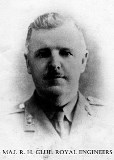
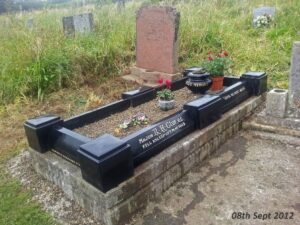
William John Goodridge, Serjeant, 3850764, Royal Artillery. William was the son of William John and Margarette Ellenore Goodridge, of Tenby. He married Ada Lucy Holmes, of Reading, Berkshire in 1933. He served with 551 Coast Regiment, Royal Artillery. William must have been killed in an accident, as another man of his battery died the same day as him, on Sunday 10 May 1942. William was 36 years old, and is buried at Reading (Henley Road) Cemetery.
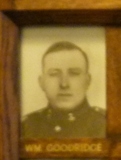
Donald Edward Grant, Pilot Officer, 133564, Royal Air Force Volunteer Reserve. Donald was the son of Thomas Edward and Edith Annie Grant, of Totton, Hampshire. He married Mary Ann Clisby in 1941. He served with 102 Squadron, RAF, which was a bomber Squadron, one of its officers being George Leonard Cheshire, VC, and was based at RAF Pocklington, flying the Lancaster. Donald was killed on a bombing mission over Germany on 5 March 1943. He was 24 years old, and is commemorated on the Runnymede Memorial, Surrey.
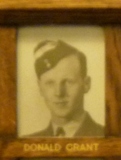
George Henry Griffiths, Sergeant (Air Gunner), 1835969, Royal Air Force Volunteer Reserve. George was the son of Harold Hector Griffiths and Alice Maud Griffiths (nee Rees), of Tenby. He served with 630 Squadron, RAF, which flew the Lancaster heavy bomber. On the night of 20 February 1944, George took off from RAF East Kirby aboard Lancaster III, Serial JB710, as part of a bombing group bound for Stuttgart. Sadly his aeroplane was one of two which were lost that night, with no survivors, and was never found. George was 19 years old, and is commemorated on the Runnymede Memorial, Surrey.
William Lionel Horner, Sub Lieutenant, Royal Naval Volunteer Reserve. William was the son of Alfred Lionel and Gladys Joyce Horner, of Tenby. He served aboard the aircraft carrier HMS Furious. When World War II started, Furious was attached to the Home Fleet, mostly hunting U-boats in the Atlantic, and carrying bullion to Canada. She took part in Operation Pedestal, carrying aircraft to Malta, and after a refit in the United States, Furious took part in Operation Torch, the landings in North Africa, in November 1942. In 1943, she took part in strikes against German shipping, and attacked the German Battleship Tirpitz in Altafjord, Norway. William was killed on 11 February 1944. He was 21 years old, and is commemorated on the Lee-On-Solent Memorial, Hampshire.
Rowena Hulton, Corporal, 888042, Women’s Auxiliary Air Force. Rowena was the daughter of Colonel Frederick Courteney Longuet Hulton, C.B., 1st Dragoon Guards, and Nellie Hulton, of Brynhir, Tenby. She served with the Women’s Auxiliary Air Force, based at Inverness. Rowena took ill and died on 20 June 1941, aged 44, and is buried at Inverness (Tomnahurich) Cemetery, Scotland
John Oliver Ingham, Major, IA/996, Royal Deccan Horse. John was the son of Lieutenant Colonel Robert John Fitzgerald Ingham, DSO, and of Ella Prendergast Ingham, of Tenby. He was commissioned into the Indian Army in September 1932, and during the war served with the Royal Deccan Horse (9th Horse), Indian Armoured Corps. John survived the war, but died in Karachi on 18 February 1947, aged 34. He is buried at Karachi War Cemetery, Pakistan. John’s father, Robert John Fitzgerald Ingham, was killed during WW1, but neither man is commemorated at Tenby.
Richard Benjamin Vaughan James, Second Radio Officer, Merchant Navy. Richard was the son of William Benjamin James, and Lily Kate James (nee Vaughan), of Tenby. He served in the Merchant Navy, aboard SS Zurichmoor, a London registered cargo steamer. Zurichmoor, which was owned by Moor Line Ltd, had been sailing independently from Halifax, Nova Scotia to St. Thomas, Virgin Islands in ballast after crossing the Atlantic in Convoy ON-90. The ship and her crew of 44 never reached St. Thomas. The ship was not officially classed as missing/untraced until 29 July 1942. A German radio message was later intercepted claiming the ship had been sunk by U-432 on 23 May 1943 East of Philadelphia. Richard was 18 years old, and is commemorated on the Tower Hill Memorial, London.
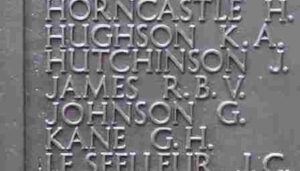
Desmond Charles James Calcutt John, Guardsman, 2735127, Welsh Guards. Desmond was the son of Harry John and Veneda Rachiel John (nee Calcutt), of Tenby. He was a regular soldier, serving with the 1st Battalion, Welsh Guards at the outbreak of war. The Welsh Guards moved to France as part of the BEF, and took up positions in the city of Arras on 17 May 1940. In May 1940, the Germans launched their Blitzkrieg into France, and Arras was bombed heavily on 19 May, with heavy fighting following. On 24 May the Welsh Guards were ordered to withdraw, and began a fighting retreat towards Dunkirk. Desmond was killed during a brief, but fierce, rearguard action at West Cappel on 29 May 1940. The German advance was delayed, but at a heavy cost to the Welsh Guards. Desmond was 20 years old, and is buried at West Cappel Churchyard, Belgium.
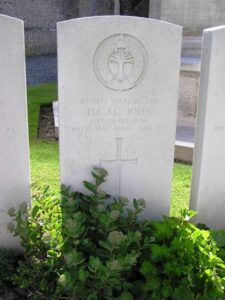
Jack Garner Jones, MID, Lieutenant, Royal Marines. Jack was born in 1922. He married Lelgarde De Clare John, the daughter of Police Sergeant J. H. John, of Tenby in 1944, prior to embarking for the Far East with No. 42 Royal Marine Commando. Jack was killed in Burma on 31 January 1945, aged 22, and was posthumously Mentioned in Despatches. He is buried at Taukkyan War Cemetery, Myanmar. Jack is not commemorated at Tenby.
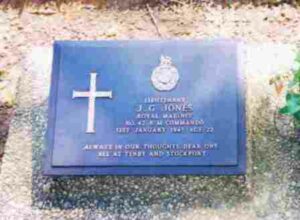
Charles Henry Burman King, Private, 3974340, Pioneer Corps. Charles was born at Cardiff in 1907, the son of James and Mary Grace King, of 32a Allen Bank Crescent, Cathays, Cardiff. He married Amy P Davies at Cardiff in 1929. He served with the Pioneer Corps during the war, probably working on the coastal defences in Pembrokeshire. He died on 29 June 1942, aged 35, and is buried at Tenby (St. Mary) Church Cemetery, Wales. Charles is not commemorated at Tenby.
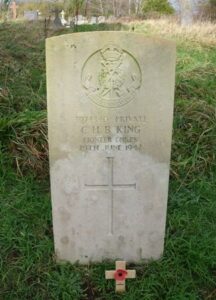
Miss Evaline Annie King, Civilian Air Raid Victim. Evaline was born at Neyland on 20 January 1917, the daughter of Herbert Edward King and Eva King (nee Davies). The family moved to Tenby when Evaline was young. During the war Evaline lived at 111, Banstead Road, Caterham. She was 24 years old when she was killed during the German Blitz on 16 April 1941.
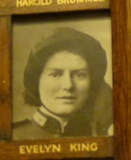
Ronald David Charles Lewis, Private, 14206532, Somerset Light Infantry. Ronald was the son of Mr. and Mrs. F. Lewis, of Tenby. He served with the 4th Battalion, Somerset Light Infantry, which was training for its part in the invasion of Normandy when Ronald died on 29 May 1944, aged 21. He is buried at Tenby (St. Mary) Church Cemetery.
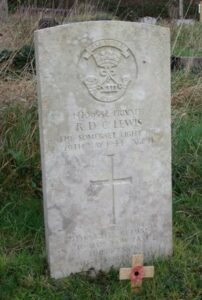
Samuel Snell Lewis, Ordinary Seaman, LT/JX 170661, Royal Naval Patrol Service. Samuel was the son of Thomas Snell Lewis and Elizabeth Martha Lewis, of Tenby. He married Madge Vera Clark, of Tenby in 1934. He served in the Royal Naval Patrol Service aboard HM Trawler Argyllshire. She had been hired in September 1939 and converted for anti-submarine duties, joining the 11th Anti Submarine Striking Group, and took part in Norwegian campaign in April and May 1940. She then took part in the evacuation of Dunkirk, but was sunk by a torpedo from a German E-boat off Dunkirk on 1 June 1940. Samuel died aboard the ship that day. He was 27 years old, and is commemorated on the Lowestoft Naval Memorial, Suffolk. His widow lost two brothers during the war, Eric and Lionel Clark.
Frank Stanley Mason, Lieutenant, 149207, Reconnaissance Corps. Frank was the son of David Richard and Selina Machel Mason, of Tenby. He married Dorothy Lilian Dunkley, of Cricklewood, Middlesex in 1932. He had volunteered for special duties, and joined No. 2 Commando sometime after 1941. Frank was then attached to the Reconnaissance Corps, and landed on the beach at Salerno on 9 September 1943, and was killed in action just four days later, on 13 September 1943. He was 31 years old, and is buried at Salerno War Cemetery, Italy.
Jack Cosby Mason, Lieutenant, Royal Navy. Jack was the son of Frank Britten Mason and Maria Isabel Mason, of North Cliff House, Tenby. He married Evelyn Frances Theresa Thrupp in 1932. He served at HMS Nile, which was a shore establishment, rather than an actual vessel. Based at Ras el Tin Point, Alexandria, Nile had a large number of personnel on the books, and Jack was based in Egypt. Jack died on 6 January 1943, aged 33, and is buried at Heliopolis War Cemetery, Greece.
John Herbert Newman, Sergeant, CH/X. 101252, Royal Marines. John was born in 1916. He served with the 15th Battalion, Royal Marines during the war. John died on 1 August 1941, aged 25, and is buried at Tenby (St. Mary) Church Cemetery. John is not commemorated at Tenby.
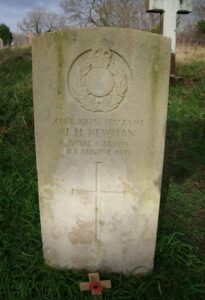
John William Nicholas, Major, Indian Army, 26th Punjabis. John was the elder son of John William Nicholas, Clerk to Carmarthen County Council, and Kate Ley Nicholas (nee Driburg). John served as a J.P., and lived at Maestilo, Llandeilo. He had joined the Indian Army in 1914, and fought throughout WW1 in Egypt and Palestine. In 1924 he was invalided out of the Army with the rank of Captain, and moved into Local Government, serving as High Sheriff in 1936-37, and being a Deputy Lieutenant and Justice of the Peace, as well as serving on Carmarthen County Council. In 1939 John re-enlisted with the rank of Major, into the Pioneer Corps. He was employed by the War Office to take charge of the organisation of Pioneer Corps throughout Wales, and was then seconded to the Ministry of Food in Cardiff. John died in Hospital in London in August 1943 after undergoing an operation, leaving his widow and 11 year old son behind. No more is known of him.
Richard Charles Andrew Nicholl, Marine, PLY/X 1995, Royal Marines. Richard was the son of Charles Thomas Nicholl and Mary Sophia Nicholl (nee Meyrick), of Tenby. He served aboard the aircraft carrier HMS Glorious. On the afternoon of Saturday 8 June 1940 HMS Glorious and her escorting destroyers HMS Acasta and HMS Ardent were intercepted in the Norwegian Sea by the German battle-cruisers Gneisenau and Scharnhorst while returning from supporting the British forces in Norway. The three British ships were sunk by gunfire in a little over two hours, with the loss of over 1,500 officers and men. Richard was one of the missing. He was 21 years old, and is commemorated on the Plymouth Naval Memorial, Devon.
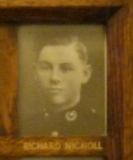
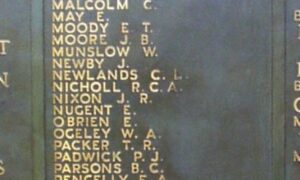
John Paul Vipond Nicholls, MID, Squadron Leader (Pilot), 40560, Royal Air Force. John was the son of John Richard Lee Nicholls and Gladys Nicholls, of Yorkshire. He married Grace White, of Tenby, in 1941. John had been in the Royal Air Force for several years prior to the war, and served as a Pilot with 150 Squadron, Royal Air Force. The squadron was equipped with Vickers Wellingtons, operating from RAF Newton. On 9 March 1942 John was flying his Wellington on a raid over Germany when it was brought down, killing all of its crew. John was 30 years old, and is buried at Reichswald Forest War Cemetery, Germany. John is not commemorated at Tenby.
Thomas Peter Treleaven Oliver, Flight Sergeant (Pilot), 1094666, Royal Air Force Volunteer Reserve. Peter was the son of Reverend Joseph Thomas Perry Oliver and Muriel Adelaide Oliver (nee Treleaven), of Tenby. He served as a Pilot with the RAF in the Middle East. Thomas was killed in an air crash while landing his Baltimore V, Serial FW307 of No 2 Aircraft Delivery Unit, which exploded after bouncing and tipping up on landing at Castel Benito on 29 November 1943. He was 22 years old, and is buried at Tripoli War Cemetery, Libya.
Charles Howard Page, Plumber 3rd Class, D/MX 66337, Royal Navy. Charles was the son of Charles and Flora Page, of Tenby. He married Annie Jones of Llandebie in 1938. He served aboard H.M.S. Charybdis, which was a Dido Class Destroyer, and was part of the Home Fleet. She transferred to the North Atlantic Command in April 1942, and set sail for the Mediterranean, where she took part in escort duties on the Malta Convoys, and aided in the North African Campaign, and at the landings at Salerno. She returned to the Atlantic, where on 21 October 1943 was ordered to intercept a German Supply ship. She was hit by two torpedoes on 23 October 1943, fired from two German torpedo boats, and sank with the loss of 462 men. Charles was one of these men, and was 33 years old. He is remembered on the Plymouth Naval Memorial.
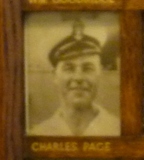
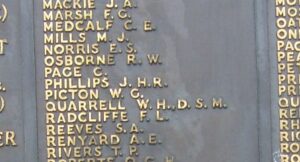
Samuel Oliver Alec Palmer, Warrant Officer Class II (C.S.M.), 6007427, Lancashire Fusiliers. Samuel was born at Romford, Essex on 27 January 1910, the son of Charles and Lily Palmer. He was probably stationed with the Essex Regiment at Penally when he met and married Kathleen Barbara (Kitty) Clark at Tenby in 1933, and the couple resided with Kitty’s parents at Laston House, in Tenby Harbour. The couple had four children, Margaret, Colin, Roy, and Robin. Samuel was a well known athlete, and in 1939 he was the British Athletic Association 6 mile record holder. At some time prior to 1943, Samuel was posted to the 1st Battalion, Lancashire Fusiliers, which was in the Far East, attached to 77 Brigade of the famous Chindits. On 5 March 1944 the Chindits flew into Burma, to take part in their second operation against the Japanese. Samuel was killed in action during the assault on the Japanese garrison at Moguang on 18 June 1944. He was 34 years old, and is buried at Taukkyan War Cemetery, Myanmar. Samuel is not commemorated on the Tenby Memorial. Many thanks to Neil Palmer for the details.
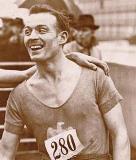
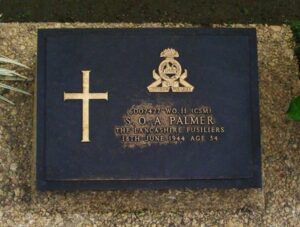
Paul Parbury, MC and Bar, Major, 56597, Royal Artillery. Paul was the son of Lieutenant Colonel Ernest Parbury and Doris Brooke Parbury, of Tenby. He was admitted to Sandhurst in 1932, and left in 1933 to become a Second Lieutenant with the Royal Artillery. By 1941 he was posted to North Africa with 124 Field Regiment, Royal Artillery. Paul won two Military Crosses for his bravery during the fighting in North Africa: his first award was gazetted on 24 September 1942 and his second in recognition of gallant and distinguished services in the Middle East was gazetted on 1 June 1943. The story behind Paul’s first award of the Military Cross is interesting. His unit was taking part in the fighting to break out of the Gazala Box, and Paul was in a bren gun carrier when a soldier of the East Yorkshire Regiment flagged him down and ordered him to silence a machine gun post holding up the platoon’s advance. ‘Major Parbury, without hesitation, charged with the carrier and silenced the post. When he returned the subaltern told him to silence another post and the major promptly charged again and silenced the second gun.’ Paul was killed in the ensuing invasion of Italy on 14 July 1943. He was 29 years old, and is buried at Catania War Cemetery, Sicily.
Colin Aveston Rees, Ordinary Seaman, D/JX 651040, Royal Navy. Colin was the son of George Howard Rees and Sophia Ann Rees (nee Rees), of Pembroke Villas, Tenby, and served aboard the light cruiser HMS Diomede. Diomede had taken part in several naval actions during the early part of the war, but had become obsolete, and was transferred to Rosyth for use as a training vessel. Colin died at Rosyth on 17 January 1944. He was 18 years old, and is buried at Tenby (St. Mary) Church Cemetery.
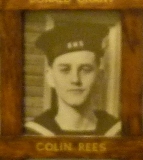
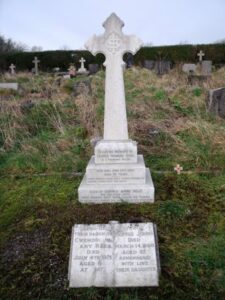
John Rees, Aircraftman 1st Class, 1296970, Royal Air Force Volunteer Reserve. John was the son of John and Margaret Rees, of 3, Bridge Street, Tenby. He married Doris May Williams, of Tenby in 1933. He served in India with the Royal Air Force, and died there on 2 December 1942. John was 33 years old, and is buried at Ranchi War Cemetery, India.
David Ernest Stuart Richards, Aircraftman 2nd Class, 1153338, Royal Air Force Volunteer Reserve. David was the son of Thomas H. Richards and Emily Richards, of New Hedges. He served with the Royal Air Force. He died in Pembrokeshire on 6 September 1941, aged 20, around the time of the Battle of Britain, and is buried at Tenby (St. Mary) Church Cemetery.
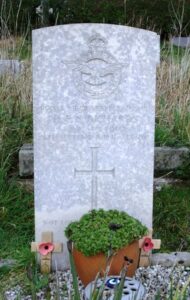
John David Richards, MID, Chief Petty Officer, Royal Navy. John was the son of John Edward and Sophia Richards, of 4, The Green, Tenby. He was a long serving Royal Navy rating and towards the end of the war served at HMS Drake. She was an old monitor, which had proved to be of no use, and so was used for training of stokers. John was mentioned in despatches during the war, and died at Plymouth on 24 November 1944, aged 44. He is buried at Tenby (St. Mary) Church Cemetery.
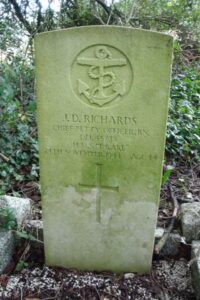
William Peter Shand, DFC, Wing Commander (Pilot), 33285, Royal Air Force. William was the son of William and Josephine Shand, of Caldy Island. On 1 August 1936 Peter passed out from Cranwell, and was granted a commission as Pilot Officer. When war broke out Peter was posted to 139 (Jamaica) Squadron, Royal Air Force, which was an elite unit, equipped with the De Havilland Mosquito. On 20 April 1943 Peter took off from RAF Marham, in Norfolk, for a raid on the Dutch coast. His Mosquito, Serial DZ386, crashed at Ijsselmeer, killing Peter and his navigator, Christopher Handley. William was 27 years old, and is buried alongside Christopher at Wonseradeel (Makkum) Protestant Churchyard, Netherlands. William is not commemorated at Tenby.
Anthony Sinnatt, Civilian Concentration Camp Victim. Anthony was the juvenile son of Lieutenant John Anthony Hamilton Sinnatt, Royal Artillery, and of Louise Sinnatt (nee Lewis), of Tenby. He was captured along with his parents during the Japanese invasion of Sumatra. Sadly Anthony lost his mother Louise when she died on 23 February 1945, and within weeks the young Anthony died at Lahat, Sumatra on 14 April 1945. Anthony was just six years old.
Louise Sinnatt (nee Lewis), Civilian Concentration Camp Victim. Louise was the daughter of Mrs. E. Turner Lewis, of 3 Cresswell Street, Tenby. She had married Lieutenant John Anthony Hamilton Sinnatt, of the Royal Artillery in 1937. The family then embarked for the Far East following John’s posting to Sumatra. Louise was taken prisoner, along with John and their baby son, during the Japanese invasion of Sumatra, and died at Muntok, Banka Island, Sumatra on 23 February 1945, leaving her six year old son to fend for himself until he sadly died on 14 April. Louise was 32 years old.
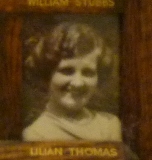
William Henry Stubbs, Petty Officer, D/JX. 130395, Royal Navy. William was the son of William Henry and Elizabeth Ann Stubbs, of Tenby, and was known to his friends as Ginger. He had married Nancy Davies prior to the outbreak of war, and lived with her at Penally. Ginger served with the Royal Navy, as a Petty Officer, aboard HMS Cattistock, a Type I ‘Hunt’ Class Destroyer. Cattistock had been launched on 22 February 1940, and took part in the evacuation of troops from Le Havre during August 1940, receiving heavy damage. On 29 August 1944, William was aboard HMS Cattistock, while she was on duty in the Channel, alongside the frigate HMS Rettalick. The ships were intercepted by a group of German vessels, who were evacuating Le Havre. In the subsequent battle, the Cattistock received over 20 direct hits, including one to the bridge which killed the ship’s captain and several of her crew, including Ginger. His daughter was just four months old when he died and his wife Nancy never remarried. A plaque in memory of Ginger was placed on the wall of Tenby’s Fisherman’s Chapel, by the harbour, by his widow. William was 32 years old when he died that day, and his body was brought home to be buried at St. Mary Church Cemetery, Tenby.
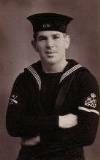
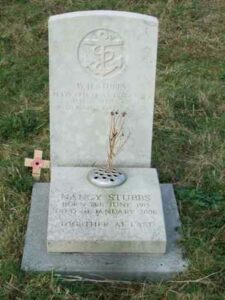
Annie Dinah Thomas, Civilian Air Raid Victim, Civilian. Annie was the widow of George Thomas, and lived at St. Ronan’s, Queen’s Parade, Tenby. She died there during the only air raid on Tenby on 12 October 1941, aged 76, and is buried at Tenby.
Archibald Elwyn Thomas, Trooper, 7957756, Royal Armoured Corps. Archie was the son of Thomas Benjamin Thomas and Jane Thomas (nee Hay), of Tenby. He served with the 48th Royal Tank Regiment, part of the Royal Armoured Corps. They were equipped with the Churchill Tank, and fought in North Africa and Italy during the war. Archibald must have been wounded at some time, and returned home for treatment. He died on 29 January 1945, aged 22, and is buried at Tenby (St. Mary) Church Cemetery.

Frank Gilbert Thomas, Guardsman, 2738575, Welsh Guards. Frank was the son of Charles Hermann D Thomas and Alice Martha Thomas (nee Lovatt), of Tenby. He served with the 1st Battalion, Welsh Guards. In June 1944 the 1st Battalion Welsh Guards landed in Normandy, attached to 32nd Guards Brigade, Guards Armoured Division. During the coming weeks, the Welsh Guards took part in the break-out from the Normandy beach-head, and in the drive into Belgium. Frank was killed in Belgium on 5 September 1944. He was 19 years old, and is buried at Auderghem (Oudergem) Communal Cemetery, Belgium.
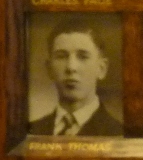
Norman Haskell Thomas, Deck Hand (Gunner), Merchant Navy. Norman was born at Tenby on 21 April 1921, the son of Cyril John Childs Thomas and Elizabeth Thomas (nee George). The family later moved to Chatham. Norman served aboard SS Gairsoppa, a Glasgow registered vessel. Gairsoppa was carrying a cargo of pig iron, tea, general cargo and silver ingots from Calcutta to London in convoy SL.64 when she was detached to Galway due to lack of fuel. Unfortunately, just after midnight on 17 February 1941, en route to Galway, she was torpedoed and sunk by U-101. Three lifeboats were launched, but only one man reached land alive. Norman was one of six survivors left alive in their lifeboat when it capsized in surf off The Lizard, Cornwall on 1 March 1941, drowning all of the men. Norman was 20 years old, and is buried at Landewednack (St. Winwallow) Churchyard, Cornwall.
Hugo Moreton Waddington Thomas-Ferrand, Wing Commander, 34032, Royal Air Force. Hugo was born on 30 August 1913, the son of Commander Richard Thomas Waddington Thomas-Ferrand, Royal Navy, and Rachel Eira Moreton Thomas-Ferrand. Hugo was educated at Charterhouse between 1927 and 1931, before joining the Royal Air Force in 1933. He married Joyce Margaret Gibbon, of London in 1940. Hugo was serving as Wing Commander towards the end of the war, and was on leave in Tenby when he suddenly died on 29 March 1945, aged 32. Hugo is buried at Tenby (St. Mary) Church Cemetery. Hugo is not commemorated locally.
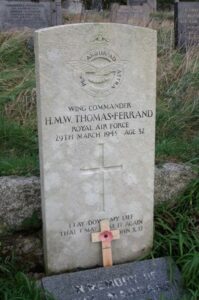
Reginald John Toms, Private, 6146258, The Buffs (Royal East Kent Regiment). Reginald was from Plymouth. He married Thelma Greenstock, of Tenby in 1941. He served with the 5th Battalion, The Buffs, which was attached to 36 Brigade, 78th Division. The division served in the North African campaign. Reginald was killed in North Africa on 15 April 1943, aged 23, and is commemorated on the Medjez-El-Bab Memorial, Tunisia. Reginald is not commemorated at Tenby.
Edward George Vare, Serjeant, 7880459, Royal Armoured Corps. Edward was the son of Percy and Elizabeth Mary Vare of Penally. He had married in 1935, and lived with his wife Maud Vare, at Waungilwen, Cardiganshire. Edward served with the 12th Royal Tank Regiment, Royal Armoured Corps, which fought in North Africa, before taking part in the invasions of Sicily and Italy. Edward was killed in action in Tunis on 6 May 1943. He was 32 years old, and is buried at Massicault War Cemetery, Medjez-el-Bab, Tunis.
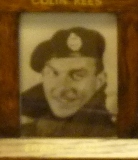
Michael Herbert St John Wallis, Marine, PO/X 4834, Royal Marines. Michael was born at Tenby on 29 April 1920, the son of Lieutenant-Commander William Wallis and Mary Wallis (nee Emerton). The family later moved to 5, Sydney Buildings, Bath. Michael was educated at Monkton Combs before enlisting into the Royal Marines, and served aboard the battlecruiser HMS Hood. Hood was patrolling around Iceland with HMS Prince of Wales on 24 May 1941, when they sighted the German pocket Battleship Bismarck. The mighty ships opened fire on each other, and a salvo of shells from Bismarck hit the aft magazines of Hood, causing a huge explosion which blew the ship apart and killed all bar three of her crew of 1,418. Michael was 21 years old when he died that day, and is commemorated on the Portsmouth Naval Memorial, Hampshire. Michael is not commemorated at Tenby.
Hanvar Walters, Sapper, 1881335, Royal Engineers. Hanvar was born on 17 October 1912, the son of Thomas Arthur and Emma Walters, of 13, Edward Street, Tenby. He married Violet Theresa Dando, of Pembroke, in 1934, and the couple lived at 1, Tor Lane, Tenby. Hanvar was a stonemason and had served with the Royal Naval Volunteer Reserve for several years prior to the war. Because of his trade he was transferred to the Royal Engineers and posted to 930 Port Construction Company, Royal Engineers. Little else is known of him, but he died near Bridgend on 27 August 1941, aged 28, and is buried at Tenby (St. Mary) Church Cemetery.
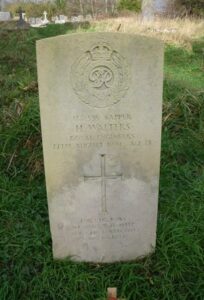
Neville Philip Warlow, Sergeant (Air Gunner), Royal Air Force. Neville was born in Tenby in 1924, the son of John Warlow and Maud Alice Warlow (nee Chaplin). The family later moved to Swanscombe, Kent, and served with 103 Squadron, RAF. The squadron was a heavy bomber unit, equipped with the Avro Lancaster, and based at RAF Elsham Wolds in Lincolnshire. Neville was killed during a bombing raid over Germany on 28 May 1944. He was 19 years old, and is commemorated on the Runnymede Memorial, Surrey.
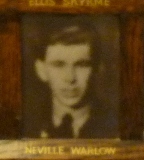
Charles Oliver Webb, Serjeant, 833203, Royal Artillery. Charles was the son of John and Mary Ellen Webb, of Bishop Auckland. He married Constance May Harries, of Tenby, on 2 September 1939. Charles served with 239 Battery, 77 Heavy Anti Aircraft Regiment, Royal Artillery, and embarked with the battery for the Far East soon after the outbreak of war, arriving at Singapore early in February 1942. Charles was captured in Java after the Japanese had invaded the British Fortress Island of Singapore, leading to its surrender on 15 February 1942. He survived twenty-one months in captivity before being embarked aboard the Japanese transport Suez Maru in November 1943, to be shipped to Japan for forced labour, along with 545 other British prisoners. Unfortunately, the Suez Maru was spotted and torpedoed on 29 November 1943 by the American submarine U.S.S. Bonefish, and sank. The survivors were machine gunned in the water by the Japanese, leaving no survivors. Charles was 30 years old, and is commemorated on the Singapore Memorial.
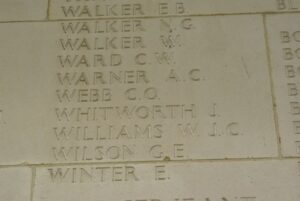
Margaret Holiday Weight, Aircraftwoman 2nd Class, 2037142, Women’s Auxiliary Air Force. Margaret was the daughter of Harry Ewart Weight and Olive Margaret Weight, of Tenby. She served with the Women’s Auxiliary Air Force. Margaret died on active service on 16 December 1942, aged 25, and is buried at Penarth Cemetery, Glamorganshire. Margaret is not commemorated at Tenby.
Richard Edmund Wilson, Sergeant (Observer), 565833, Royal Air Force. Richard had been educated at Monmouth School, before joining the Royal Air Force. He had served at Basra for three years prior to the war, when he was posted to RAF Carew Cheriton. Richard met and married Myfanwy Dobson, from Tenby while stationed at Carew in 1939. He was killed when his Hawker Henley, Serial L3427 crashed at Nash Villa on 23 April 1940. Richard is buried at Carew (St. Mary) New Churchyard. His widow gave birth to their daughter five months later.
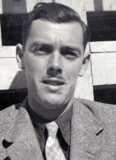
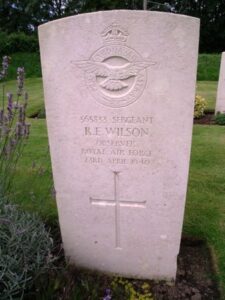
Reginald Victor Wonnacott, Fisherman, Fishing Fleet. Reginald was born at Tenby on 22 June 1897, the son of Frederick George Wonnacott and Mary Ann Wonnacott (nee Harries). His father, a fisherman, was originally from Devon, but had settled in Tenby, before later moving the family to Hakin Point, Milford Haven. Reginald followed in his fathers shoes, becoming a fisherman after leaving school and as a seaman, enlisted into the Royal Naval Reserve on 3 February 1915. After completing his Royal Naval training, he then served throughout the Great War aboard a number of converted trawlers, on anti-submarine patrol duties. Reginald had spent the latter part of the war based at Aberdeen, and remained there after the Armistice, marrying a local girl, Isabella Duguid. The couple resided at Swansea for several years, where their son was born, before returning to Scotland and settling again at 20, Craigie Street, Aberdeen. Reginald then joined the crew of the Aberdeen registered Steam Trawler River Ness. On 10 June 1940 River Ness was fishing in the North Sea when she was attacked by German aircraft and was sunk with the loss of eight of her crew of ten men. Reginald was 42 years old when he died that day. He has no known grave so is commemorated on the Tower Hill Memorial, London. Reginald is not commemorated locally.
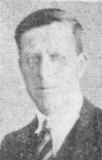
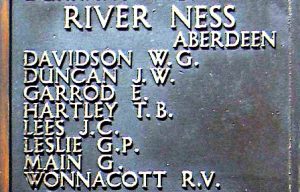
There is also the grave of an unknown Merchant Sailor buried at Tenby (St. Mary’s) Churchyard, whose body was buried at Tenby on 18 January 1943.
